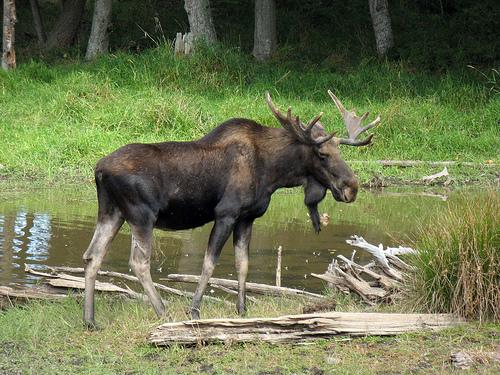Declining moose population in upper Midwest may be due to climate change
According to Seth Moore, Bull moose are declining at a steeper rate than cows. (Photo from Flickr user Sir Frog.)
Whether in the opening credits of Northern Exposure or in the fictional town of Frostbite, Minn., moose are most often associated with cold climates.
But Bullwinkle could become a rarity in Minnesota, as the moose population continues to decline.
“We’ve been seeing a long term population decline since 1990,” said Seth Moore, director of Biology and Environment for the Grand Portage Band of Chippewa in Minnesota. “We’re seeing lower number of bulls compared to cows, we’re seeing fewer calves on the landscape. So, we’re trying to determine what the causes are for the population decline. We’re concerned that moose are going in the same direction as the polar bear populations in the Arctic, and we hope that we can be effective before the population decline has gone too far.”
Part of the reason Moore believes the declining moose population may be similar to that of the polar bear has to do with climate change. He said the Chippewa area saw the lowest snow fall numbers in years. He referred to it as a “non-winter.”
“So, in winter, moose tend to exhibit heat stress at 20 degrees Fahrenheit. Well, most of our winter was about 20 degrees Fahrenheit, so these animals are stressed out for the entire winter,” Moore said.
Moore said snow depth has been down since 1950, and while the winters have been milder, the summers have been warmer by about five degrees Fahrenheit. In addition to heat-related deaths, moose are more susceptible to parasites as a result of a lack of cold. For example, ticks are more likely to survive winter if it is short and mild.
“The other two parasites that affect moose significantly are brain worms and liver flukes,” Moore said. “Both of these are passed by deer, and our deer numbers are high because our winters are less severe. Winter is the population control for deer numbers in this area.”
Moore said the decline in moose population may be as large as 65 percent since 1990. For the upper Midwest, losing moose could mean losing a cultural icon.
“Moose are the primary subsistence species to the Grand Portage band. And so, as such, they really define the culture of the band. If we lose the moose population here, we’re losing part of the identity of the Grand Portage band of Chippewa,” Moore said.
As was the case of the classic study on the predator-prey system of Isle Royale, wolves, one of the few predators to moose, keep the number of moose down. However, Moore said the number of wolves is closely correlated with the number of deer, and both populations are on the rise.
“And so, even if wolves are mostly eating deer during their diet, when wolf numbers are high, they’re encountering moose more often, and so we’re also probably getting a little bit of increased predation by wolves as well, just because deer numbers are high,” Moore said.
Moore said his group is attempting to manage their deer population in order to stabilize growth. They are also trying to reduce wildfire suppression, which would bring down the number of ticks in the area. If the decline in moose population is linked to climate change, it is possible more may need to be done to ensure a proper climate for moose in the northern Midwest.
At The World, we believe strongly that human-centered journalism is at the heart of an informed public and a strong democracy. We see democracy and journalism as two sides of the same coin. If you care about one, it is imperative to care about the other.
Every day, our nonprofit newsroom seeks to inform and empower listeners and hold the powerful accountable. Neither would be possible without the support of listeners like you. If you believe in our work, will you give today? We need your help now more than ever!
